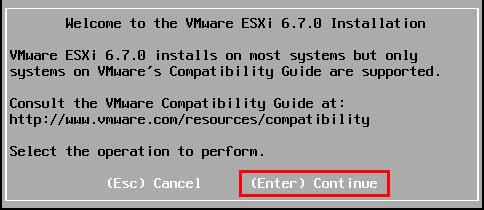
- #VMWARE VSPHERE 6.5 INSTALLATION GUIDE FULL#
- #VMWARE VSPHERE 6.5 INSTALLATION GUIDE SOFTWARE#
- #VMWARE VSPHERE 6.5 INSTALLATION GUIDE CODE#
- #VMWARE VSPHERE 6.5 INSTALLATION GUIDE PC#
#VMWARE VSPHERE 6.5 INSTALLATION GUIDE CODE#
Security is part of our DNA and I can say that because I see the real interest when I discuss things with engineers who are VERY proud of the code they write and strive to make it the best they can. We will continue our move to even more “secure by default”. There are very few that fall under the classification of “hardening” and 75% of those don’t have a big attack surface. There are many settings VMware can’t set and those are “Site Specific”. What this shows is that we’ve made great strides towards “secure by default”.
#VMWARE VSPHERE 6.5 INSTALLATION GUIDE SOFTWARE#
You would run this tool only after you’ve determined that 3rd party software accessing your infrastructure (Backup, monitoring, etc) supported TLS 1.2. We offer a simple tool to disable these versions so running that tool would technically be considered “hardening. The last, disabling TLS 1.0/1.1, is not turned on by default because if we did that and you had 3rd party software that accessed systems using TLS 1.0 or 1.1, the connection would break. 1 is “Apply your ESXi patches”… Not exactly “hardening” but whatever.3 are to set a standard vSwitch’s settings from accept to reject.(In other words, NOT a gaping hole situation) These are all “Risk Profile 1” settings and as I called out in a previous blog, they have little to no code in the ESXi hypervisor and are mainly interesting only to those customers who believe every setting must have a value even if there is no code backing it. Of these settings 18 are under the VM.disable-unexposed-features.*banner. After all, it’s 24 settings out of 68! Well let’s break down those settings. An example would be the IP Address for your NTP server. “Non-Hardening” means that either the default setting is the desired setting or the setting is a “Site Specific” setting meaning it’s something VMware can’t set for you. For vSphere 6.5, only 35% of the settings are “hardening”. So, with all of this work to make things more secure, is the guide really “hardening” things? Based on my findings, not nearly as much as you would think. These efforts are done under an abundance of caution, long before the threat can be made into something actionable. That’s why you see actions like the disablement of Transparent Page Sharing a couple of years ago. We track all the latest research and come up with strategies to mitigate future threats. Second, we are constantly evolving our architecture. Today, we ask ourselves “Can we ship this “hardened” and then it’s up to the customer to loosen the screws if he/she sees fit?”. Security was always there but it usually meant “tightening the screw” to achieve the desired results. First, we started by moving to a “secure by default” mindset when it came to security. Especially so over the past 3 to 4 years. But we here at VMware have been responding. The threat vectors and attacks have changed and the targets are constantly shifting. Now everyone is asking about security out of the gate. Time to market and the excitement of selling and nobody really asking too much about security was the modus operandi.

#VMWARE VSPHERE 6.5 INSTALLATION GUIDE PC#
Not unlike the many changes in our industry that have happened before (If you were around for the start of the PC revolution it was the wild, wild West in terms of security!). Our marketplace started on its path to maturity.

Security folks were only just barely starting to notice this and started asking good questions. Workloads were only just getting moved to production on ESX back then. When the guide was conceived security wasn’t quite the “thing” it is today. When we stripped that out and went to ESXi we dropped the number of security issues by around 90%.
#VMWARE VSPHERE 6.5 INSTALLATION GUIDE FULL#
A hypervisor with a full blown Linux VM that ran all of the management functions. There was no ESXi with its limited attack surface and small size. When the Hardening Guide was conceived the world was a different place. But like everything else in this world, change comes and change is good. Well, I didn’t come up with that name, folks who created it many, many years ago called it that. Security Configuration Guide? What’s that you ask? That’s what now used to be called the “vSphere Hardening Guide”.


 0 kommentar(er)
0 kommentar(er)
